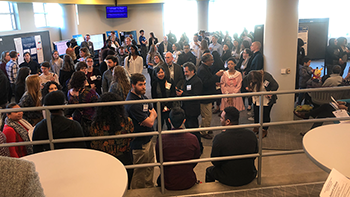Single-Cell Characterization of Clostridioidies difficile Motility Using Anaerobic Live Cell Microscopy
Description/Abstract/Artist Statement
Clostridioidies difficile (C.difficile) is an anaerobic bacterium responsible for CDI (Clostridioidies difficile infection), a common problem in hospitals and for people using antibiotics, due to the bacteria’s resistance to common treatments and ready appetite for sugar byproducts in the intestine. C.difficile has proven to be resistant to multiple antibiotic families, including beta lactams and fluroquinolones. The bacteria have two forms: dormant spores that persist in the environment and spread the infection, and vegetative cells, which proliferate within the host colon and produce virulent toxins. Little is known about the behavior of vegetative cells within hosts, because they are strict anaerobes and killed by the environmental oxygen. It is known that the organism is a motile, flagellated bacterium which swims through liquids and can even traverse the surface of solids through the extension and retraction of pili in vitro. Here, we demonstrate a novel methodology for capturing active imagery of the microbe at the level of individual cells, and show that the epidemic C.difficile strain R20291 has its motility regulated by the presence of different sources of energy that it is cultured in. This provides a superior ability to analyze distribution patterns of bacteria outside the anaerobic chamber, in addition to showing that this distribution is highly regulated by the nutritional substrate available to the microbe. Different concentrations of both arabinose and glucose showed no difference in motility for C.difficile, whereas higher concentrations of the mucus component N-actylneuraminic acid (Neu5Ac) caused significant reductions in movement and direction changes in the bacteria. This suggests that C.difficile responds to substrate nutrient type and concentration through changes in behavior and may actively target gut mucus as a colonization site.
Faculty Advisor/Mentor
Erin Purcell
Presentation Type
Poster
Disciplines
Biochemistry
Session Title
Poster Session
Location
Learning Commons, Atrium
Start Date
2-8-2020 8:00 AM
End Date
2-8-2020 12:30 PM
Single-Cell Characterization of Clostridioidies difficile Motility Using Anaerobic Live Cell Microscopy
Learning Commons, Atrium
Clostridioidies difficile (C.difficile) is an anaerobic bacterium responsible for CDI (Clostridioidies difficile infection), a common problem in hospitals and for people using antibiotics, due to the bacteria’s resistance to common treatments and ready appetite for sugar byproducts in the intestine. C.difficile has proven to be resistant to multiple antibiotic families, including beta lactams and fluroquinolones. The bacteria have two forms: dormant spores that persist in the environment and spread the infection, and vegetative cells, which proliferate within the host colon and produce virulent toxins. Little is known about the behavior of vegetative cells within hosts, because they are strict anaerobes and killed by the environmental oxygen. It is known that the organism is a motile, flagellated bacterium which swims through liquids and can even traverse the surface of solids through the extension and retraction of pili in vitro. Here, we demonstrate a novel methodology for capturing active imagery of the microbe at the level of individual cells, and show that the epidemic C.difficile strain R20291 has its motility regulated by the presence of different sources of energy that it is cultured in. This provides a superior ability to analyze distribution patterns of bacteria outside the anaerobic chamber, in addition to showing that this distribution is highly regulated by the nutritional substrate available to the microbe. Different concentrations of both arabinose and glucose showed no difference in motility for C.difficile, whereas higher concentrations of the mucus component N-actylneuraminic acid (Neu5Ac) caused significant reductions in movement and direction changes in the bacteria. This suggests that C.difficile responds to substrate nutrient type and concentration through changes in behavior and may actively target gut mucus as a colonization site.


